Doers and Dreamers | Celebrating Black History
 Our top choice for a collective biography this year is Andrea Davis Pinkney’s Hand in Hand: Ten Black Men Who Changed America (Disney, 2012; Gr 6 Up). Last week Hand in Hand won the 2013 Coretta Scott King Award, and rightly so. In the Preface to the book, Pinkney writes of visiting a reading clinic attended by young men “who sought direction in the books they read.” In this title, all children will find role models. Beginning with Benjamin Banneker and ending with Barack Obama, the accounts span three centuries and a range of occupations from scientist and orator to Supreme Court Justice and President of the United States. The author devotes significant space and detail to the histories, influences, and impact of these men—men that join part of a “cohesive chain…marching together into the lives” of readers. Each chapter begins with a poem about the subject by Davis Pinkney, and a full-page watercolor portrait by Brian Pinkney. The impressionist images are rendered in black line on pages of bright colors. Touches of purple, red, or gold, and swirling lines highlight facial features in these vivid, close-up studies. Smaller images spotlight group scenes and a couple of poignant reminders of an earlier era: a water fountain labeled “COLORED" and a Pullman Porter cap. The Doers
Our top choice for a collective biography this year is Andrea Davis Pinkney’s Hand in Hand: Ten Black Men Who Changed America (Disney, 2012; Gr 6 Up). Last week Hand in Hand won the 2013 Coretta Scott King Award, and rightly so. In the Preface to the book, Pinkney writes of visiting a reading clinic attended by young men “who sought direction in the books they read.” In this title, all children will find role models. Beginning with Benjamin Banneker and ending with Barack Obama, the accounts span three centuries and a range of occupations from scientist and orator to Supreme Court Justice and President of the United States. The author devotes significant space and detail to the histories, influences, and impact of these men—men that join part of a “cohesive chain…marching together into the lives” of readers. Each chapter begins with a poem about the subject by Davis Pinkney, and a full-page watercolor portrait by Brian Pinkney. The impressionist images are rendered in black line on pages of bright colors. Touches of purple, red, or gold, and swirling lines highlight facial features in these vivid, close-up studies. Smaller images spotlight group scenes and a couple of poignant reminders of an earlier era: a water fountain labeled “COLORED" and a Pullman Porter cap. The Doers 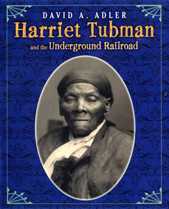 David Adler, the prolific author of both fiction and nonfiction titles, has just released with Holiday House a biography, Harriet Tubman and the Underground Railroad (2013; Gr 4-8). Published in commemoration of the 100th anniversary of the death of this indefatigable humanitarian, the book covers her life from her childhood years (when she was volleyed between slave owners); her years as a conductor on the Underground Railroad; time spent as a cook, nurse, and spy for the Union army; and her later years, when she established a home for “elderly former slaves.” This well-researched title incorporates primary resources including excerpts from The National Era, The Christian Recorder, and the Douglass’ Monthy, newspapers offering the African-American community’s point-of-view and reaction to events of the period; black-and white archival photos and reproductions; documented quotes; and other valuable resources for student researchers.
David Adler, the prolific author of both fiction and nonfiction titles, has just released with Holiday House a biography, Harriet Tubman and the Underground Railroad (2013; Gr 4-8). Published in commemoration of the 100th anniversary of the death of this indefatigable humanitarian, the book covers her life from her childhood years (when she was volleyed between slave owners); her years as a conductor on the Underground Railroad; time spent as a cook, nurse, and spy for the Union army; and her later years, when she established a home for “elderly former slaves.” This well-researched title incorporates primary resources including excerpts from The National Era, The Christian Recorder, and the Douglass’ Monthy, newspapers offering the African-American community’s point-of-view and reaction to events of the period; black-and white archival photos and reproductions; documented quotes; and other valuable resources for student researchers. 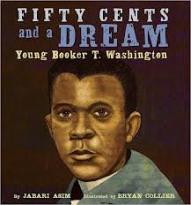 His wallet was small but his dream was big–huge really–for a young man born into slavery in the American South of the 1800s: Booker T. Washington wanted to read and write. With the gift of a spelling book from his mother and powerful inspiration from a literate African American man, he was on his way. After emancipation, Washington heard about Hampton Institute and was determined to study there. With Fifty Cents and a Dream (Little, Brown, 2012; Gr 2-6) he walked the 500 miles to the school, stopping along the way to earn money. The book ends with Washington’s arrival at Hampton and the hope it held for its students. Gorgeous, full-page collage and watercolor illustrated on sepia-toned paper depict the youth in prayer, in labor, and in study. The generous back matter presents additional facts about Washington, notes from the author Jabari Asim and illustrator Bryan Collier, and a bibliography.
His wallet was small but his dream was big–huge really–for a young man born into slavery in the American South of the 1800s: Booker T. Washington wanted to read and write. With the gift of a spelling book from his mother and powerful inspiration from a literate African American man, he was on his way. After emancipation, Washington heard about Hampton Institute and was determined to study there. With Fifty Cents and a Dream (Little, Brown, 2012; Gr 2-6) he walked the 500 miles to the school, stopping along the way to earn money. The book ends with Washington’s arrival at Hampton and the hope it held for its students. Gorgeous, full-page collage and watercolor illustrated on sepia-toned paper depict the youth in prayer, in labor, and in study. The generous back matter presents additional facts about Washington, notes from the author Jabari Asim and illustrator Bryan Collier, and a bibliography. 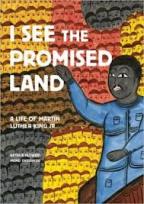 There are many books about Martin Luther King, Jr., but none like Arthur Flowers’s I See the Promised Land (Groundwood, 2013; Gr 9 Up). The book is illustrated by Manu Chitrakar, an artist working in the Padua style of Bengal region of India. That traditional art is a form of scroll painting used in storytelling and performance; here it’s adopted to present the Civil Rights leader’s story in a graphic format. A minimal text featuring generous quotes from King’s historic speeches define his evolution as a thinker and a leader, and later, his doubts and fears about the direction of the Civil Rights Movement. Featuring a broad palette of deep, bold colors and stylized figures, and the Flowers’s poetic intonations, King’s legacy becomes one that transcends time and place in this stunning book. The Dreamers
There are many books about Martin Luther King, Jr., but none like Arthur Flowers’s I See the Promised Land (Groundwood, 2013; Gr 9 Up). The book is illustrated by Manu Chitrakar, an artist working in the Padua style of Bengal region of India. That traditional art is a form of scroll painting used in storytelling and performance; here it’s adopted to present the Civil Rights leader’s story in a graphic format. A minimal text featuring generous quotes from King’s historic speeches define his evolution as a thinker and a leader, and later, his doubts and fears about the direction of the Civil Rights Movement. Featuring a broad palette of deep, bold colors and stylized figures, and the Flowers’s poetic intonations, King’s legacy becomes one that transcends time and place in this stunning book. The Dreamers  Bill Traylor was born in 1854 near Benton, Alabama to an enslaved woman on the Traylor farm. When the Civil War ended, his family stayed on as sharecroppers. Bill farmed on the Traylor’s land until 1935, when in his eighties, with his family scattered, he headed to nearby Montgomery. There he worked at a shoe factory until his rheumatism forced him to stop. Without work, but not without friends, Traylor was offered a place to sleep in the storage area of a local business establishment. It was about that time that the octogenarian picked up paper and a pencil and It Jes’ Happened (Lee & Low, 2012). In his book, Don Tate relates the story of Traylor’s life and art, and the discovery of Traylor by a young artist that led to exhibits and recognition. Characterizing Traylor as “talkative,” Tate peppers the text with quotes by the man that touch on the memories he translated into art. R. Gregory Christie’s paintings, featuring bold, flat colors, and depicting solid figures and animals (often in profile), mirror those that the self-taught painter created during his lifetime. Source notes and an afterword add more details about this humble man and his extraordinary art.
Bill Traylor was born in 1854 near Benton, Alabama to an enslaved woman on the Traylor farm. When the Civil War ended, his family stayed on as sharecroppers. Bill farmed on the Traylor’s land until 1935, when in his eighties, with his family scattered, he headed to nearby Montgomery. There he worked at a shoe factory until his rheumatism forced him to stop. Without work, but not without friends, Traylor was offered a place to sleep in the storage area of a local business establishment. It was about that time that the octogenarian picked up paper and a pencil and It Jes’ Happened (Lee & Low, 2012). In his book, Don Tate relates the story of Traylor’s life and art, and the discovery of Traylor by a young artist that led to exhibits and recognition. Characterizing Traylor as “talkative,” Tate peppers the text with quotes by the man that touch on the memories he translated into art. R. Gregory Christie’s paintings, featuring bold, flat colors, and depicting solid figures and animals (often in profile), mirror those that the self-taught painter created during his lifetime. Source notes and an afterword add more details about this humble man and his extraordinary art. 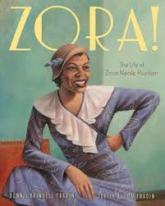 One of the last informational texts by the late Dennis Brindell Fradin, Zora! The Life of Zora Neale Hurston (2012; 5-8) celebrates the life of the indomitable African American woman who gained international recognition during the Harlem Renaissance. Co-written with Judith Bloom Fradin, the accessible and thorough biography is complete with archival photos, reproductions, source notes, and an index. The prolific and award-winning team’s fascinating subject led an impoverished, yet full life. With jobs ranging from Hollywood movie writer and college professor to doctor’s receptionist and maid, the charismatic Hurston never stopped spinning tales. Counting Langston Hughes and Alain Locke as critics and friends, she has made a lasting contribution to American literature, though she died in relative obscurity at age 69. In the 1970s, her most well-known work, Their Eyes Were Watching God gained renewed attention from writers such as Alice Walker. Hurston was always proud of her African American heritage and confident in her writing prowess. Young readers will be inspired by her unconquerable spirit to strive like she did “for a toe-hold on the world.”
One of the last informational texts by the late Dennis Brindell Fradin, Zora! The Life of Zora Neale Hurston (2012; 5-8) celebrates the life of the indomitable African American woman who gained international recognition during the Harlem Renaissance. Co-written with Judith Bloom Fradin, the accessible and thorough biography is complete with archival photos, reproductions, source notes, and an index. The prolific and award-winning team’s fascinating subject led an impoverished, yet full life. With jobs ranging from Hollywood movie writer and college professor to doctor’s receptionist and maid, the charismatic Hurston never stopped spinning tales. Counting Langston Hughes and Alain Locke as critics and friends, she has made a lasting contribution to American literature, though she died in relative obscurity at age 69. In the 1970s, her most well-known work, Their Eyes Were Watching God gained renewed attention from writers such as Alice Walker. Hurston was always proud of her African American heritage and confident in her writing prowess. Young readers will be inspired by her unconquerable spirit to strive like she did “for a toe-hold on the world.” 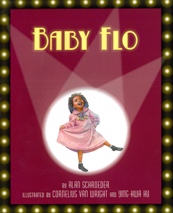 Florence Mills’s voice was never recorded, and no films of her performances have been found, and yet her indelible mark on music history can never be erased. Flo’s effervescent personality and unique talent was evident from a young age. Alan Schroeder’s Baby Flo (Lee & Low, 2012; Gr 3-5) concentrates on the entertainer’s early life and career. The daughter of former slaves, Flo and her sisters helped their family survive in one of the poorest Washington DC neighborhoods by collecting debris to stoke the oven in their frigid home. Her talent for singing, dancing, and charming a crowd was discovered early, and she was soon cakewalking into the hearts of African American audiences everywhere. Cornelius Van Wright and Ying-Hwa Hu illustrate the child’s enthusiasm and love for the stage in bright watercolor scenes. Text and art unite to express the effusive energy bursting from this child who would one day become an internationally renowned artist.
Florence Mills’s voice was never recorded, and no films of her performances have been found, and yet her indelible mark on music history can never be erased. Flo’s effervescent personality and unique talent was evident from a young age. Alan Schroeder’s Baby Flo (Lee & Low, 2012; Gr 3-5) concentrates on the entertainer’s early life and career. The daughter of former slaves, Flo and her sisters helped their family survive in one of the poorest Washington DC neighborhoods by collecting debris to stoke the oven in their frigid home. Her talent for singing, dancing, and charming a crowd was discovered early, and she was soon cakewalking into the hearts of African American audiences everywhere. Cornelius Van Wright and Ying-Hwa Hu illustrate the child’s enthusiasm and love for the stage in bright watercolor scenes. Text and art unite to express the effusive energy bursting from this child who would one day become an internationally renowned artist. 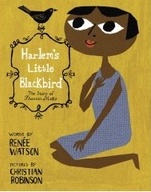 An essential part of the Harlem Renaissance’s early jazz scene, Mills’s achievements in fighting against segregation plays a major role in Renée Watson’s picture book biography, Harlem’s Little Blackbird (Random, 2012; K-3 ). Encompassing a broader view of her life, this title covers the songstress’s humble beginnings and touches upon her early death, and her lasting influence. The narrative highlights an incident in which the little girl refused to perform at a theater that wouldn’t allow her friends in the audience because of the color of their skin. Later in her career, in London, she wowed listeners despite their prejudice against black performers; her powerful voice mesmerizing crowds wherever she went. Watson adeptly handles bleaker sides of Flo’s story, especially with the poetic description of her song’s final note. At the age of 31, Flo Mills died from tuberculosis on November 1, 1927. Christian Robinson’s mixed-media art is never more striking than in the book’s final spread, in which blackbirds fill the skies of Harlem as 150,000 mourners flood the streets to say goodbye to the “Little Blackbird.”
An essential part of the Harlem Renaissance’s early jazz scene, Mills’s achievements in fighting against segregation plays a major role in Renée Watson’s picture book biography, Harlem’s Little Blackbird (Random, 2012; K-3 ). Encompassing a broader view of her life, this title covers the songstress’s humble beginnings and touches upon her early death, and her lasting influence. The narrative highlights an incident in which the little girl refused to perform at a theater that wouldn’t allow her friends in the audience because of the color of their skin. Later in her career, in London, she wowed listeners despite their prejudice against black performers; her powerful voice mesmerizing crowds wherever she went. Watson adeptly handles bleaker sides of Flo’s story, especially with the poetic description of her song’s final note. At the age of 31, Flo Mills died from tuberculosis on November 1, 1927. Christian Robinson’s mixed-media art is never more striking than in the book’s final spread, in which blackbirds fill the skies of Harlem as 150,000 mourners flood the streets to say goodbye to the “Little Blackbird.”  Gary Golio and Rudy Gutierrez’s Spirit Seeker (Clarion, 2012; Gr 4-6) recounts the spiritual journey of jazz’s legendary John Coltrane, from preacher’s grandson to haunted drug addict and restored virtuoso to music master. Not shying away from the details of his harrowing sojourn into depression and substance abuse, Golio’s composition is honest and lyrical. He examines how the twin forces of music and religion shaped Coltrane’s early life and were his saving grace in his later years. A true labor of love, Spirit Seeker is perfect marriage of art and text.
Gary Golio and Rudy Gutierrez’s Spirit Seeker (Clarion, 2012; Gr 4-6) recounts the spiritual journey of jazz’s legendary John Coltrane, from preacher’s grandson to haunted drug addict and restored virtuoso to music master. Not shying away from the details of his harrowing sojourn into depression and substance abuse, Golio’s composition is honest and lyrical. He examines how the twin forces of music and religion shaped Coltrane’s early life and were his saving grace in his later years. A true labor of love, Spirit Seeker is perfect marriage of art and text. Gutierrez’s psychedelic art, reminiscent of the saxophonist’s intricate work, underscores the musician’s tumultuous path with his use of light and dark. The artist’s and author’s notes, an afterword, and extensive back matter provide insight into the book creators’ thought process and connection with their subject. Just as jazz was Coltrane’s pulpit, budding artists will be inspired to find their own outlet for expression. Related articles of interest: Joy Fleishhacker’s article, “Great Books for Celebrating Martin Luther King Day.”
Jennifer M. Brown's "A Mission Above and Beyond Them: An Interview with Tanya Lee Stone."
RELATED
The job outlook in 2030: Librarians will be in demand
The job outlook in 2030: Librarians will be in demand
ALREADY A SUBSCRIBER? LOG IN
We are currently offering this content for free. Sign up now to activate your personal profile, where you can save articles for future viewing






Add Comment :-
Comment Policy:
Comment should not be empty !!!
Professional Resources - Celebrating Black History Month
[...] Library Journal’s “Doers and Dreamers” includes new resources to help celebrate Black History Month. under: Black History, [...]Posted : Feb 08, 2013 07:12